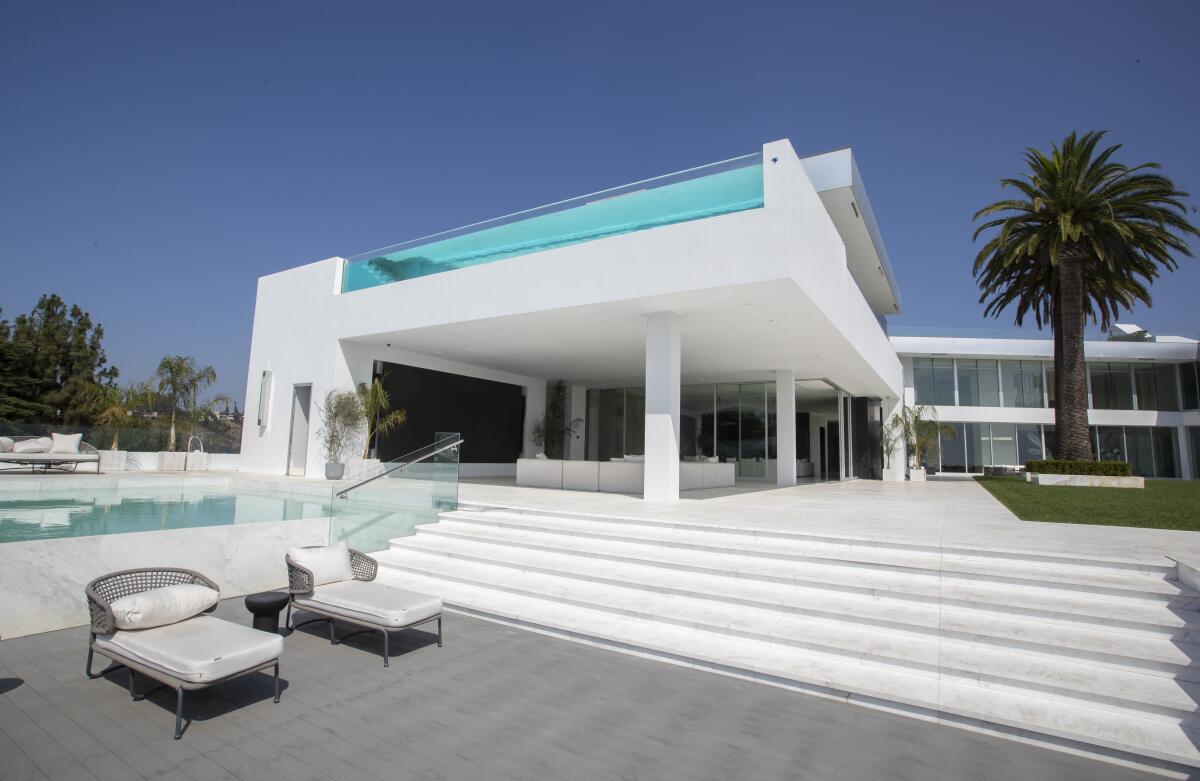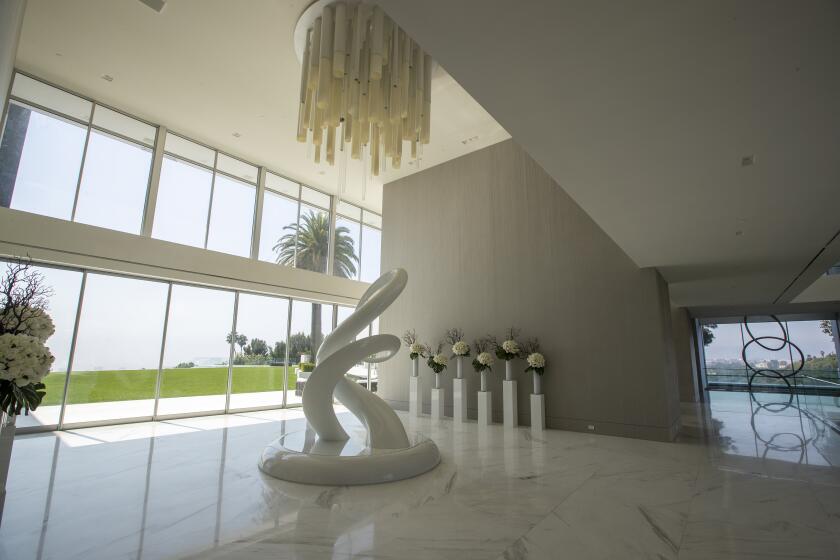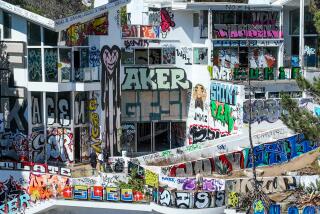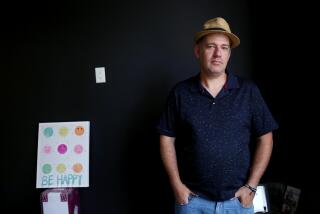The auction of The One mansion was a dud. Now the fight over the proceeds is getting ugly

- Share via
When the megamansion known as The One was auctioned off in March for less than half its $295-million list price, it wasn’t just a deal for the buyer: It set the stage for what is turning out to be a nasty fight among creditors.
The $141-million sale of the 105,000-square-foot property to L.A. fashion mogul Richard Saghian meant that some major lenders of the bankrupt Bel-Air project could be out of the money, given claims against the estate totaling more than $250 million. Now, one lender has filed a lawsuit claiming unfair business practices against another and alleging forgery of a document making it second in line to be repaid.
The lawsuit was filed last month in U.S. Bankruptcy Court by the investment firm of Julien Remillard, a former longtime associate of developer Nile Niami. The home’s bankrupt limited liability company, Crestlloyd, had sought court permission to pay nearly $104 million out of the $138 million the estate received from the auction to a different lender, Los Angeles billionaire Don Hankey.
Hankey Capital is by far the largest creditor of the estate, having made three loans totaling more than $100 million to Crestlloyd starting in 2018 when Niami was in search of cash to finish the opulent mansion. At issue is repayment of the first and its related interest and fees.
The estate has already paid priority claims such as taxes, and with such a large payout going to Hankey, there would be little left for other creditors, including Remillard’s Inferno Investment, which claims it is owed $20.9 million. Inferno says it and related entities loaned about $18 million for the acquisition of the property on Airole Way in 2013 and to start construction on what was then going to be a 40,000-square-foot house.
Though Inferno lent before Hankey Capital, the lawsuit acknowledges Inferno signed an agreement in 2016 allowing Crestlloyd to repay later loans needed to finish the mansion even before Inferno was repaid for its own investment.
However, that 2016 deal also required Crestlloyd to obtain approval from Remillard, the scion of a rich Quebec family, for specific loans that would become senior to Inferno’s debt, according to the lawsuit. It alleges that never happened. Instead, the lawsuit claims that Remillard’s signature was forged on an October 2018 subordination agreement allowing Hankey to be paid first.
Inferno is asking in its lawsuit for a Bankruptcy Court judge to move it to the front of the line for repayment among the estate’s big secured creditors.
The idea was simple: Nile Niami would build and sell The One, the biggest and most extravagant new home in the country. Then things went sideways.
The lawsuit doesn’t allege who conducted the forgery but says Niami’s longtime notary falsely notarized that Niami and Remillard signed the document in his presence in Los Angeles when Remillard was actually in Montreal that day. The notary did not return calls for comment.
The lawsuit also accuses Hankey Capital of unfair business practices, among them by charging an exorbitant default interest rate. Inferno has not objected to the payment of $82.5 million in principal on the disputed $104-million payout to stop the accumulation of interest, though it has reserved the right to claw it all back from Hankey.
The lawsuit further seeks to have the 2016 agreement declared null and void because it alleges that Crestlloyd padded invoices from contractors and suppliers working on The One and that funds were diverted to Niami and his former wife, Yvonne, either for themselves or for other properties they were affiliated with.
It claims Hankey Capital failed to monitor its loans so it could make more that would eventually go into default, generating higher interest and putting itself in a position to foreclose on the property — which it did last year, prompting the bankruptcy filing.

Hamid Rafatjoo, Nile Niami’s attorney, scoffed at the lawsuit, which does not name his client as a defendant, as little more than a ploy by the developer’s former investor to muddy up the waters. He said it was late in the game to make a claim that Hankey wasn’t first in line to be repaid given that the estate filed for bankruptcy in October.
“This has been outlined in a bankruptcy case since Day One. And only after the sale closes and there’s a disappointing sale price these theories arise,” he said. “At the end of the day, you try to kick up some dirt and see if there’s a settlement somewhere where you can get some money. My client did nothing wrong. He lost $30 million to $40 million of his own money on this project. To say that signatures were forged or that funds were misused is just a waste of time.”
Yvonne Niami could not be reached for comment.
Richard Saghian, chief executive and founder of the online retailer Fashion Nova, confirmed to The Times that he submitted the winning bid for The One — the biggest residence in Los Angeles.
Hankey said he viewed the lawsuit as possibly “posturing just to try to get something back.” He said he spoke to a “few people” at Inferno several years ago to complete the subordination deal and “that’s not at all what they said to me on a one-to-one level.”
To pursue its case, Inferno has hired prominent litigator Marty Singer, who said a private investigator looked into the dealings, leading to the lawsuit. He defended his client’s decision to bring the lawsuit more than six months after The One was placed into bankruptcy protection.
He said Inferno hadn’t been concerned about the order of the payouts until the auction bombed in March, yielding far less money than expected to repay creditors. It also had explicitly reserved the right to object to the distribution to Hankey.
“The anticipation was ... they would get paid in full, so there’d be no issue about worrying about priorities of liens or anything of that sort,” he said.
David Golubchik, the attorney for Crestlloyd, a defendant in the lawsuit, said the lawsuit has halted any more payments to Hankey and will slow the winding down of the bankrupt estate.
“We will deal with it through the court process, with discovery and depositions and trial if necessary,” he said. “We found it strange to assert this position after many months in Bankruptcy Court.”
The Bel-Air property may be the ultimate trophy home — or a giant white elephant clad in marble and glass. Billionaire bidders will pass judgment this week.
The auction of the marble-and-glass trophy property on a Bel-Air hilltop was so disappointing that some creditors sought to have it set aside and conducted again, noting it was held within a week of Russia’s invasion of Ukraine, which sent markets into turmoil, potentially scaring off bidders. There were only five bidders who participated in the auction.
However, U.S. Bankruptcy Court Judge Deborah Saltzman refused to do so, noting that it was also possible the situation would be worse. Her judgment proved prescient. While the war has faded from the headlines, inflation has heated up, causing the stock market to drop precipitously and the housing market to cool as the Federal Reserve raised interest rates in response.
Meanwhile, Saghian, the owner of fast-fashion retailer Fashion Nova, has been working with city officials as he seeks to complete the house, resolve zoning issues and get a certificate of occupancy, a spokesman said.
The One is the largest new home in Los Angeles and possibly the country. It contains 21 bedrooms and 42 full bathrooms. There is a 4,000-square-foot guesthouse, servants’ quarters, a moat and multiple pools, a wellness spa, a beauty salon, a four-lane bowling alley and a multiplex-size movie theater, among a much longer list of luxury amenities.
Byron Moldo, a Beverly Hills commercial bankruptcy attorney not involved with the case, said he expects the lawsuit could delay the resolution of The One’s bankruptcy for at least six months — all the while driving up attorneys’ fees and creating pressure for the parties to reach a settlement, which might be the idea.
“I think there are going to be voluminous documents to review. I can see the need for a handwriting expert,” he said. “This is going to become very, very expensive.”
More to Read
Inside the business of entertainment
The Wide Shot brings you news, analysis and insights on everything from streaming wars to production — and what it all means for the future.
You may occasionally receive promotional content from the Los Angeles Times.














